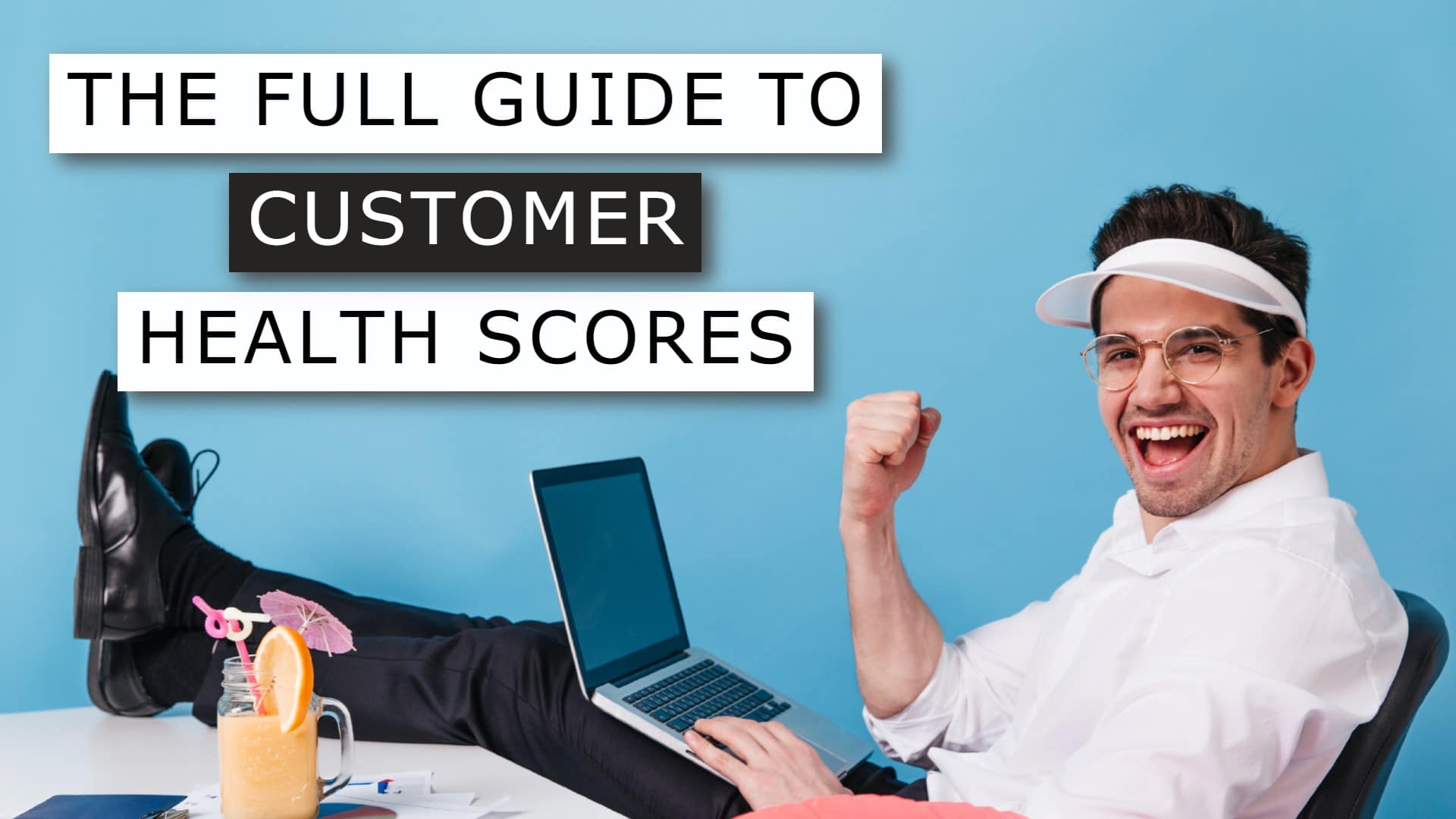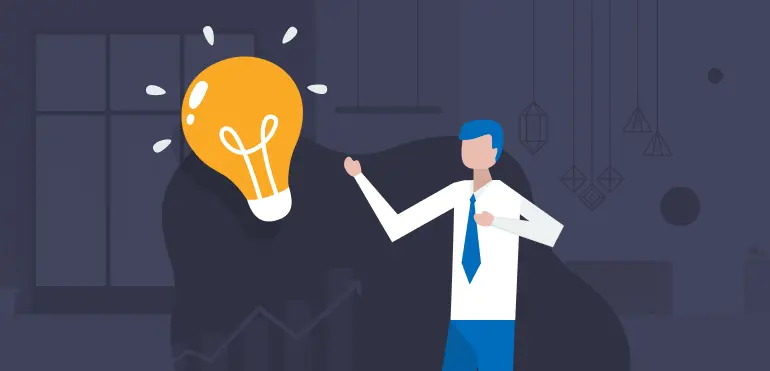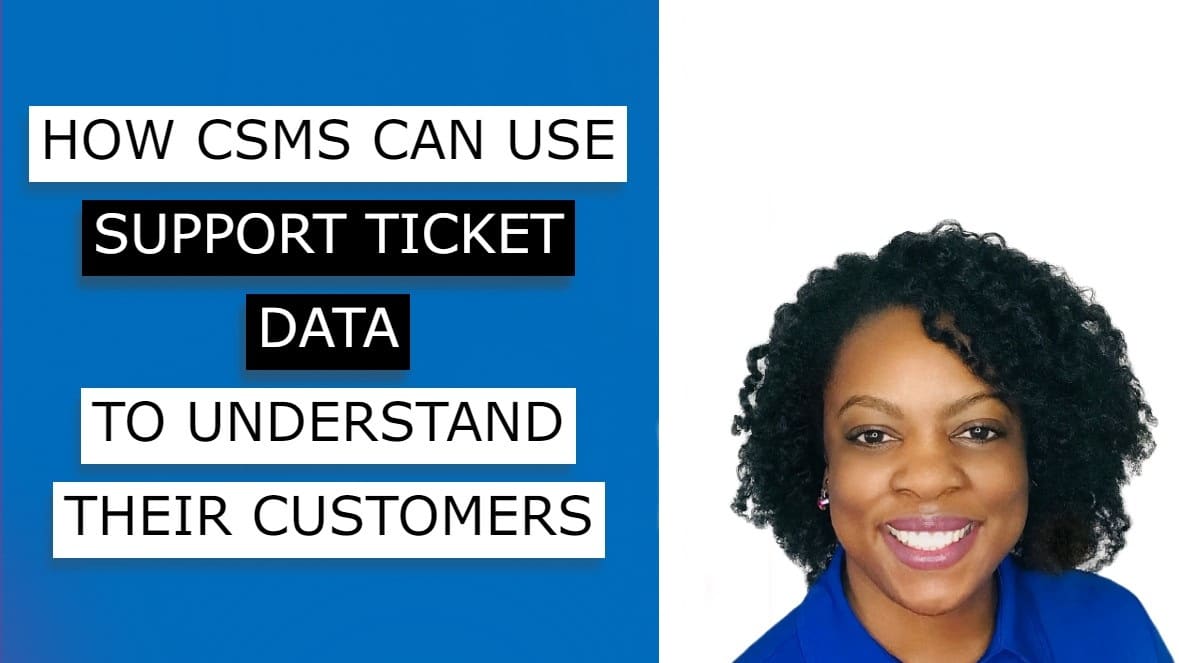Measuring the quality of customer service is a double-edged blade – it can be both useful and a nightmare.
The usefulness comes from getting a bird’s-eye view of your customers’ satisfaction and perception of your business.
The nightmare part kicks in whenever you have to decide how you’re going to measure service quality – and the inherent, intricate, and numerous minutiae that come with the process.
One of the textbook ways of doing it is through the RATER model. Today, I’m going to walk you through what it is, its pros and cons, how to make the most effective use of it in customer success, and how to use your customer success platform to speed up the process through automation.
Let’s start with the acronym itself:
What Is the RATER Model of Customer Service?
The RATER model is a method of evaluating customer service quality based on five key dimensions. The model proposed by Valarie A. Zeithaml, A. Parasuraman, and Leonard L. Berry in their 1990 book “Delivering Quality Service” is an evolution of the same group’s research into the SERVQUAL model.
The five key dimensions of the RATER Model are:
- Reliability. The business’s ability to perform and provide the promised service(s) accurately and dependably.
- Assurance. The business representative’s ability to project trust and confidence while being knowledgeable and courteous.
- Tangibles. The physical and (more recently) digital proof of a company’s status – from offices to equipment, communication documents, personnel, marketing materials, and more.
- Empathy. The ability of the company to provide personable, empathetic, caring, and personalized attention to its customers.
- Responsiveness. The business’ willingness and ability to provide timely services and help with support requests.
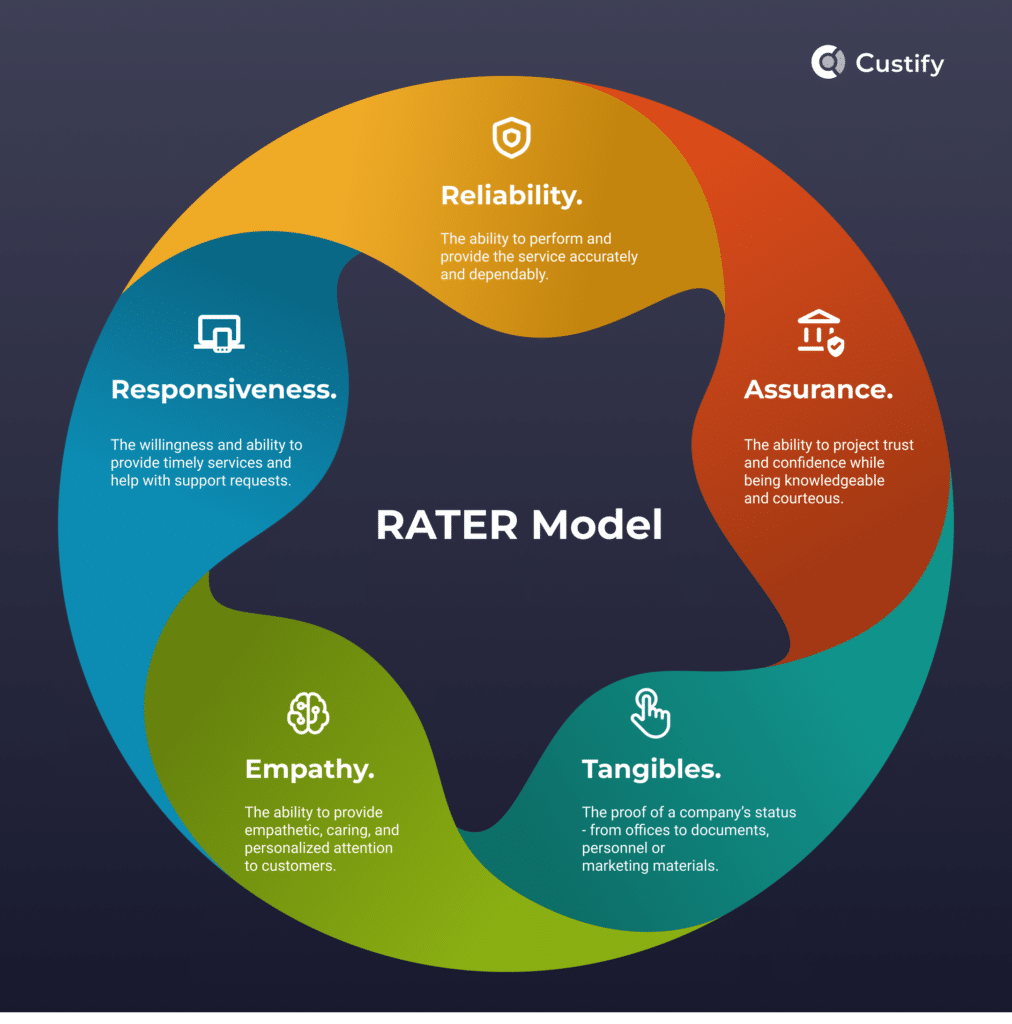
The above definitions have evolved slightly over the years – one example is the addition of digital tangibles. The language has also changed and evolved to fit current definitions within the business sector.
RATER vs SERVQUAL Dimensions
Believe it or not, the RATER Model was never supposed to be such a catchy term – Zeithaml et al. only proposed a revised and consolidated SERVQUAL model – introduced by the same authors in an article in January 1988 in the Journal of Retailing. The follow-up book lists the 5 updated dimensions as TRRAE – definitely less catchy and iconic than RATER. Though the latter seems to have stuck at some point after the book’s publication.
The SERVQUAL model features 10 dimensions for evaluating service quality: tangibles, reliability, responsiveness, competence, courtesy, credibility, security, access, communication, and understanding the customer.
These correspond to the RATER model as follows:

Source: Zeithaml et al., Delivering Quality Service: Balancing Customer Perceptions and Expectations, 1990, New York, page 25
The various statistical analyses conducted in constructing SERV-QUAL revealed considerable correlation among items representing several of the original ten dimensions. In particular, the correlations suggested consolidation of the last seven dimensions […]into two broader dimensions labeled assurance and empathy. The remaining dimensions – tangibles, reliability, and responsiveness remained intact throughout the scale development and refinement process.
– Excerpt from Delivering Service Quality, Zeithaml et al.
Advantages: Why Use the RATER Model?
Here is a list of benefits of using the RATER model for customer service:
- Scientific Approach. The SERV-QUAL and RATER frameworks were developed after rigorous scientific research that involved a 97-item survey posed to a quota sample of 200 customers.
- Tailored for Service Businesses. The model went beyond the 4 Ps of marketing and introduced a theoretical 4th P – performance – specifically for service businesses. This model applies well to the SaaS field, which often overlaps with the CS field.
- Authors’ Commentary. Possibly the best way to use the RATER model is by first reading and understanding the authors’ original thoughts, which offer a highly detailed preface to the RATER model. The original book also features highly-specific, insightful, and timeless advice for most marketing, customer service, and customer support professionals.
- Easy to Use. The RATER model is also highly self-explanatory, and apart from the knowledge of how to perform a Gap Analysis, most professionals don’t require more advanced theoretical background and should be able to easily apply it to evaluate their company’s service quality.

Source: ibid., page 10
Disadvantages: Why Isn’t the RATER Model More Popular?
Despite its usefulness and pioneering status in marketing studies, the SERVQUAL model, and by extension RATER model, have been heavily criticized. Here are the main disadvantages:
- Questionnaire length. As stated, the research that created the RATER model was based on and tested with a 97-point questionnaire. While this may be impressive and a testament to the authors’ hard work, it may also be a statistical fallacy as such a survey definitely can lead to respondent fatigue, and then the data analytics could also become time-consuming and laborious.
- Validity of the dimensions. Respondent fatigue aside, the 5 dimensions of the RATER model have been tested and proven to be scalable. However, the model authors recommend adapting the dimensions to each company’s specific needs. As such, if you adapt the dimensions and scale the model to fit your customer base, you’ll end up with skewed results, as any modified dimensions can potentially lose their scalability.
- Working with ideal models. Upon further testing, it was revealed that the SERVQUAL model elicits ideal expectations from survey respondents – in other words, those responding to the survey will think of the best-case scenario for them. This leads to unreasonable results and expectations placed on the customer service team as only the best of companies will ever have a chance of reaching those ideals (this criticism co-signed by Zeithaml herself along with Boulding, W., Kalra, A., Staelin, R. in a February 1993 entry to the Journal of Marketing Research).
- Changes in the business landscape. In the past 30 years since the RATER framework’s original publication, the business landscape has seen dramatic changes. We’ve gone through at least two paradigm shifts with the move to online and then the move to remote work. Add to that the ever-evolving customer service trends and the emergence of customer success as an essential business function, and it becomes increasingly difficult to know how to apply the model while accounting for these changes.
How to Use the RATER Model Effectively
We have used the SERVQUAL instrument in many different studies since we initially developed and tested it. Results from those studies have consistently shown reliability to be the most important dimension, and tangibles the least important.
– Excerpt from Delivering Service Quality, Zeithaml et al., page 28
1. Conduct a Gap Analysis
The first step is determining where you are now versus what your customers see as ideal. That means running a Gap Analysis to get data-driven insights into two things:
- The gaps between your customers’ expectations and their perceptions
- How to close the respective gaps and improve your overall customer satisfaction
The gap model of service quality was also engineered by Parasuraman, Zeithaml, & Berry after their research revealed significant disparities between companies’ perceptions and customers’ perceptions of service quality.
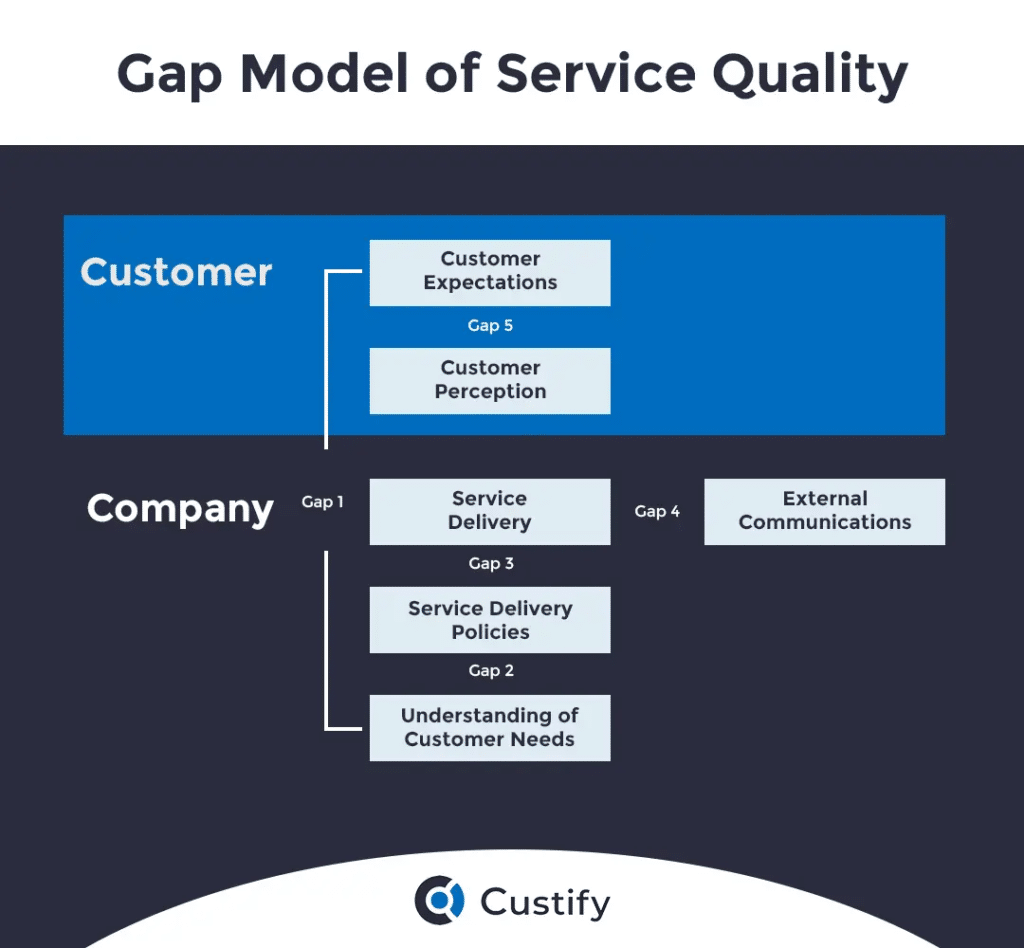
The Gap Model identifies five gaps in customer service quality that have the biggest impact on customer experience:
- The Knowledge Gap. Represents the difference between customer expectations and management’s perceptions of what those customers need and want.
- The Policy Gap. Represents the difference between management’s perceptions of customer needs and the specifications of the provided services.
- The Delivery Gap. Represents the differences between the service specifications and the service itself, i.e. the truth of what is delivered.
- The Communication Gap. Represents the differences between what a company communicates and the services it delivers.
- The Customer Gap. Represented the difference between a customer’s expectations and their perceptions – often the most undesirable gap, used to identify dissatisfied customers.
To effectively run a Gap Analysis, you have to follow these basic steps: research and determine necessary improvements, determine the gaps with your current outlook, set clear and measurable goals, understand customer expectations, and create a plan of attack. We go more in-depth on these steps in our breakdown of how to run a gap analysis for customer service.
2. Write Down Questions that Can Help You
As mentioned above, the RATER Model was originally tested through a 97-item questionnaire with basic expectation and perception statements followed by a 7-point scale from 7 (strongly agree) to 1 (strongly disagree).

Source: Zeithaml et al.., page 24
So – to effectively apply the RATER model to your use case, find statements you can add to your own customer questionnaire.
While you can apply the RATER framework by simply filling in the questionnaire yourself (based on your knowledge and experience), surveying customers directly will provide better insights and more relevant action items.
To that end, we’ve put together some statements and questions you can steal and use:
RATER Model with Examples of Statements and Questions
1. Reliability:
↪ Expectation statements:
- I expect the company to deliver services as promised, without any delays.
- I expect the company to meet the specifications and desired outcomes outlined for its services.
- I expect the company to adhere to the agreed-upon timeline for service delivery.
- I expect the company to promptly notify me of any potential delays or changes in service delivery.
- I expect the company to have the flexibility to scale its services based on my changing needs.
↪ Perception statements:
- The company consistently delivers services accurately and in a timely manner.
- The company meets the specifications and desired outcomes I have for its services.
- The company fulfills its promised service delivery timeline without delays.
- The company promptly communicates any potential delays or changes in service delivery.
- The company demonstrates the ability to scale its services based on my changing needs.
2. Assurance:
↪ Expectation statements:
- I expect the company representatives to have the necessary expertise to address my needs.
- I expect the company representatives to be knowledgeable about their products and services.
- I expect the company representatives to be polite and courteous during interactions.
- I expect the company representatives to provide reassurance and instill confidence in their abilities.
- I expect the company representatives to understand my point of view and desired outcomes.
↪ Perception statements:
- The company representatives demonstrate expertise in addressing my specific needs.
- The company representatives exhibit a high level of knowledge about their products and services.
- The company representatives are polite and courteous during interactions.
- The company representatives provide reassurance and instill confidence in their abilities.
- The company representatives understand my point of view and desired outcomes.
3. Tangibles:
↪ Expectation statements:
- I expect the company’s materials to project confidence and provide insightful advice.
- I expect the company’s offices and equipment to have a professional and well-maintained appearance.
- I expect the customer success personnel to appear capable, knowledgeable, and able to address my needs.
- I expect the company’s marketing messages to effectively communicate their value proposition.
- I expect the company’s communication documents to be well-designed and easy to understand.
↪ Perception statements:
- The company’s materials project confidence and provide insightful advice.
- The company’s offices and equipment have a professional and well-maintained appearance.
- The customer success personnel appear capable, knowledgeable, and able to address my needs.
- The company’s marketing messages effectively communicate their value proposition.
- The company’s communication documents are well-designed and easy to understand.
4. Empathy:
↪ Expectation statements:
- I expect the company representatives to interact with me in a respectful and empathetic manner.
- I expect the company representatives to demonstrate care and attentiveness to my needs.
- I expect the company representatives to personalize their interactions based on my specific requirements.
- I expect the company representatives to understand my desired outcomes and goals.
- I expect the company representatives to work with me collaboratively toward achieving my goals.
↪ Perception statements:
- The company representatives interact with me in a respectful and empathetic manner.
- The company representatives demonstrate care and attentiveness to my needs.
- The company representatives personalize their interactions based on my specific requirements.
- The company representatives understand my desired outcomes and goals.
- The company representatives work with me collaboratively towards achieving my goals.
5. Responsiveness:
↪ Expectation statements:
- I expect the company representatives to respond promptly to my support requests.
- I expect the company representatives to proactively offer assistance with company products or services.
- I expect the company representatives to provide useful help within a reasonably short timeframe.
- I expect the company representatives to demonstrate willingness and openness to provide assistance.
- I expect the company representatives to be attentive and helpful rather than annoyed by my requests.
↪ Perception statements:
- The company representatives respond promptly to my support requests.
- The company representatives proactively offer assistance with company products or services.
- The company representatives provide useful help within a reasonably short timeframe.
- The company representatives demonstrate willingness and openness to provide assistance.
- The company representatives are attentive and helpful rather than seeming annoyed by my requests.
! Note: All statements should be presented with a scale in your questionnaire (either 1-5, 1-7, or 1-10, from “strongly disagree” to “strongly agree”).
3. Apply the Gap Analysis for Every RATER Dimension
Using survey responses as VoC data, run a Gap Analysis for every specific RATER dimension, identifying any disconnects between customer expectations and your ability to provide quality services that meet those expectations.
While this might be one of the shortest points on this list, the hard truth is that it’s likely also the most tedious and time-consuming part of the process. On the upside, going through with it will provide insights you couldn’t otherwise see. How useful those insights are for your case will depend on how you apply them:
4. Determine the Areas that Need Improvement
For each dimension of the RATER model, determine whether you have any of the 5 gaps in customer service quality (knowledge, policy, delivery, communication, customer).
After going through the list of gaps, you should be able to easily identify the areas of your business that need improvement.
↪ Example Insight Gained by Using the RATER Model:
Issue Identified: There is a gap between how quickly customers would ideally like to see support requests resolved, how quickly your team is actually handling them, how the team perceives that it’s handling them, and what your marketing & sales team communicate in terms of time to resolution.
Insight Uncovered: Your support department needs to be reexamined – you need to see why the disconnect exists and propose ways in which you can eliminate it. Furthermore, sales and marketing need to be clued in so they are more aware of the truth behind your service delivery and quality.
5. Talk to Customers
It’s not enough to conduct a questionnaire and gap analyses for each RATER dimension. We recommend you also check in with customers after your research but before implementing the solutions you’ve selected.
The purpose is to see if, after such a long and arduous research and decision-making process, the proposed solutions are a good fit for your customers. As you’ve already seen – there can be gaps in every part of your business, product, or service, so it’s vital to ensure you’re not just creating more issues.
For most businesses, we recommend going to your best-fit customers or your top-performing customers and having an honest conversation about your findings and proposed responses. This will also serve to calibrate their expectations for the upcoming period of change.
6. Begin Set of Improvements
After the entire RATER gap analysis and feedback process, it’s time to get to work!
Start implementing the improvements you’ve settled on, keeping in mind that traditionally, Responsiveness is the most important dimension for customers, while Tangibles represent the least important. Here’s a full breakdown according to the research by Parasuraman, Zeithaml, and Berry.

Source: Zeithaml et al.., page 28
This is the original relative importance of the RATER model. However, considering the research behind the pie chart is over 30 years old, we recommend comparing it to your questionnaire results. Your customers are more likely to agree with statements corresponding to the dimensions they care about the most.
How CSMs Can Use the RATER Model to Achieve Success
Customer support shouldn’t be the responsibility of customer success. That said, we’ve found that 56.3% of CSMs are still responsible for it. And in the rest of the cases, CSMs are likely collaborating with support and stepping in for critical requests, often being there proactively to resolve issues without the client needing to file a ticket in the first place.
That serves to prove just how central customer success is to customer service. In many ways, CSMs today are the coordinators of customer service as they oversee alignment and collaboration on customer outcomes between all of the customer-facing teams and other stakeholders – essentially establishing a strategy for all the RATER dimensions.
As such, CS has more of a managerial and strategic role in implementing the RATER model. From these positions, CS leaders can:
- Begin the RATER model analysis. Customer success managers will be quick to notice gaps in customer service. If those pile up, then a thorough RATER review might seem like the only way to move through all the issues and solve them.
- Take part in building the RATER questionnaire. As the department with the most insights in-depth customer insights, CSMs should lead the brainstorming process for expectation and perception statements, and should have the final say on the questionnaire.
- Run the Gap Analysis for customer service. Since CS should be the department that works with all the other teams, it’s also the best one to conduct a review of the company’s customer service. Plus, the seniority of the lead CSM tends to lend itself well to comprehensive analyses.
- Decide on improvements. After sifting through customer responses and running all the respective gap analyses for each dimension in the RATER model, CSMs should propose, discuss, and decide upon solutions to the service gaps they identified.
- Customer check-ins. CSMs can also be the ones to check back in with the top customers and inform them about the upcoming changes, getting one final OK for the improvements from their customers.
- Oversee implementation. Last but not least, CSMs should keep an eye on how the measures they’ve decided upon are implemented and step in whenever they see an issue. Beyond CS-exclusive tasks, an overhaul of customer service will definitely require changes to support, product, marketing, sales, and more.
Can You Automate the RATER Model?
The RATER model itself cannot be automated and any in-depth and serious analysis should be conducted with care and attention to detail.
That said, you can automate parts of the RATER model:
- Use your customer success platform to send the RATER survey to relevant customers automatically.
- Use questionnaire data and your CS tool to automatically monitor customers that are at risk of churning.
- Use your customer portal or dashboard to identify top customers who can provide the most useful feedback on your proposed solutions.
- Use another automation flow to notify customers of upcoming product or service changes based on your RATER analysis results.
- Use automation to fix service issues and gaps you find. For example, if marketing and sales need to be clued into the product and support processes, you can use automation to add them to relevant tasks or updates from those two teams.
How’s Your SERVice QUALity?
In the above piece, I’ve reviewed the MBA textbooks, complex definitions, and reasonings behind the RATER model. We’ve shown you how to hopefully conduct one of the most thorough analyses of service quality, breaking down each step to see the why and the how.
All that’s left now is for you to find out: what’s your service quality? But remember to always check in with customers to match your analysis with their opinions so you don’t end up with even more customer service gaps!

